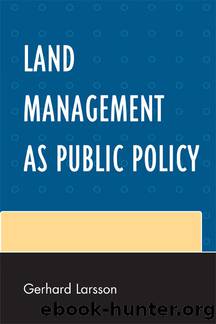Land Management As Public Policy by Larsson Gerhard;

Author:Larsson, Gerhard;
Language: eng
Format: epub
Publisher: University Press of America, Incorporated
Published: 2010-01-01T00:00:00+00:00
Method
The initiative for a project may come from various directions. A landowner might raise the issue and request property regulation from the appropriate authority. In Germany and the Netherlands, for example, the responsible authorities undertake more or less continuous surveys and initiate projects when they are considered ready for action and the resources are available. A course of action can naturally be influenced by an initiative from landowners in a specific area. It is also natural for the authority to take the initiative when property regulation is necessitated by another public project, such as the building of a major traffic route, or in connection with a measure by another authority.
The feasibility study is usually state-financed. The aim of the study is to gather an adequate basis for decisions on what infrastructure measures should be included, how the future structure should be built up, what costs would be involved for the proposed measures and how high a proportion of these costs the landowners should carry. Public authorities in many countries also like to purchase some land within the regulated area, which can later be used to enlarge remaining farming units.
The plan should also propose the delimitation of the regulation area. The process is often based on historical conditions such as village borders. This is only natural as the property mix-up has usually taken place within the framework of the village. In principle, rational reasons should be decisive and determine if the villageâs total land area should be included, or if forestry land and residential cores should be excluded.
The decision is then made on the basis of the proposed plan, often after a vote at a public meeting, after which the responsible authority makes sure that the legal requirements are met. Landowners usually have a right to oppose the decision either by turning to the courts or to a higher administrative authority.
Responsibility for implementing the formal process can be placed in various hands. In Germany, a consolidation authority is in charge, cooperating with the landowners, in France it is a specially appointed local authority sub-committee and in Sweden, Finland and Norway an appointed surveyor is responsible, assisted by selected laymen. Countries outside Europe usually have appointed officials assisted by landowner committees. In Austria, Switzerland and the Netherlands the landowners carry the whole responsibility, organised into committees with elected boards. The committees will then appoint experts (usually surveyors), who take the practical work forwards but do not have any decision-making powers.
The main goals discussed at the beginning should form the basis of the process. The preliminary project has also indicated the type of measures required. The aim is to realise the goals as far as practicable. Some such operational goals are:
⢠A reduction in the number of separate parcels is usually desirable to get shorter borders, larger farming areas and more flexibility in farming methods;
⢠At the same time, this concentration should not be taken too far at the expense of a desirable mixture of land with different soil properties and water supply conditions.
Download
This site does not store any files on its server. We only index and link to content provided by other sites. Please contact the content providers to delete copyright contents if any and email us, we'll remove relevant links or contents immediately.
The Social Psychology of Inequality by Unknown(2312)
The Plant Paradox by Dr. Steven R. Gundry M.D(2043)
The Writing on the Wall by Anselm Jappe(1759)
Working for Yourself by J.D. (Nolo) Stephen Fishman(1479)
Every Landlord's Legal Guide by Janet Portman & Stewart Marcia & Ralph Warner(1326)
The First 20 Hours: How to Learn Anything ... Fast by Kaufman Josh(1304)
ADHD on Trial by Michael Gordon(1241)
Decisive by Chip Heath(1202)
Drafting Contracts: How and Why Lawyers Do What They Do, Second Edition by Stark Tina L(1174)
Working for Yourself by Stephen Fishman J.D. (Nolo)(1140)
The Economist Aug 8th 2015 by The Economist(1123)
Restitution by Restitution(1116)
The Economist Aug 29th 2015 by The Economist(1098)
A Practical Guide to International Arbitration in London by Hilary Heilbron(1085)
The Lord of the Rings: The Fellowship of the Ring, the Two Towers, the Return of the King by J. R. R. Tolkien(1083)
Intellectual Property Strategy by John Palfrey(1082)
Collusion by Luke Harding(1045)
Persuasion by Owner(1014)
Chapter 1 by Owner(950)
